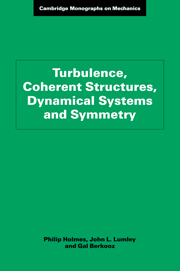9 - Low-dimensional models
Published online by Cambridge University Press: 03 February 2010
Summary
In the preceding eight chapters we have developed our basic tools and techniques. In this chapter and the next we shall illustrate their use in the derivation and analysis of low-dimensional models of the wall region of a turbulent boundary layer. First, the Navier–Stokes equations are rewritten in a form that highlights the dynamics of the coherent structures (CS) and their interaction with the mean flow. To do this, both the neglected (high) wavenumber modes and the mean flow must be modelled, unlike a large eddy simulation (LES), in which only the neglected high modes are modelled. Second, using physical considerations, we select a family of empirical subspaces upon which to project the equations. Galerkin projection is then carried out. In doing this, we restrict ourselves to a small physical flow domain, and so the response of the (quasi)local mean flow to the coherent structures must also be modelled. This chapter describes each step of the process in some detail, drawing on material presented in Chapters 2, 3, and 4. After deriving the family of low-dimensional models, in the last three sections we discuss in more depth the validity of assumptions used in their derivation. In Chapter 10 we shall describe the use of the dynamical systems ideas, presented in Chapters 5 through 8, in the analysis of these models, and interpret their solutions in terms of the dynamical behavior of the fluid flow.
Information
- Type
- Chapter
- Information
- Turbulence, Coherent Structures, Dynamical Systems and Symmetry , pp. 275 - 314Publisher: Cambridge University PressPrint publication year: 1996
